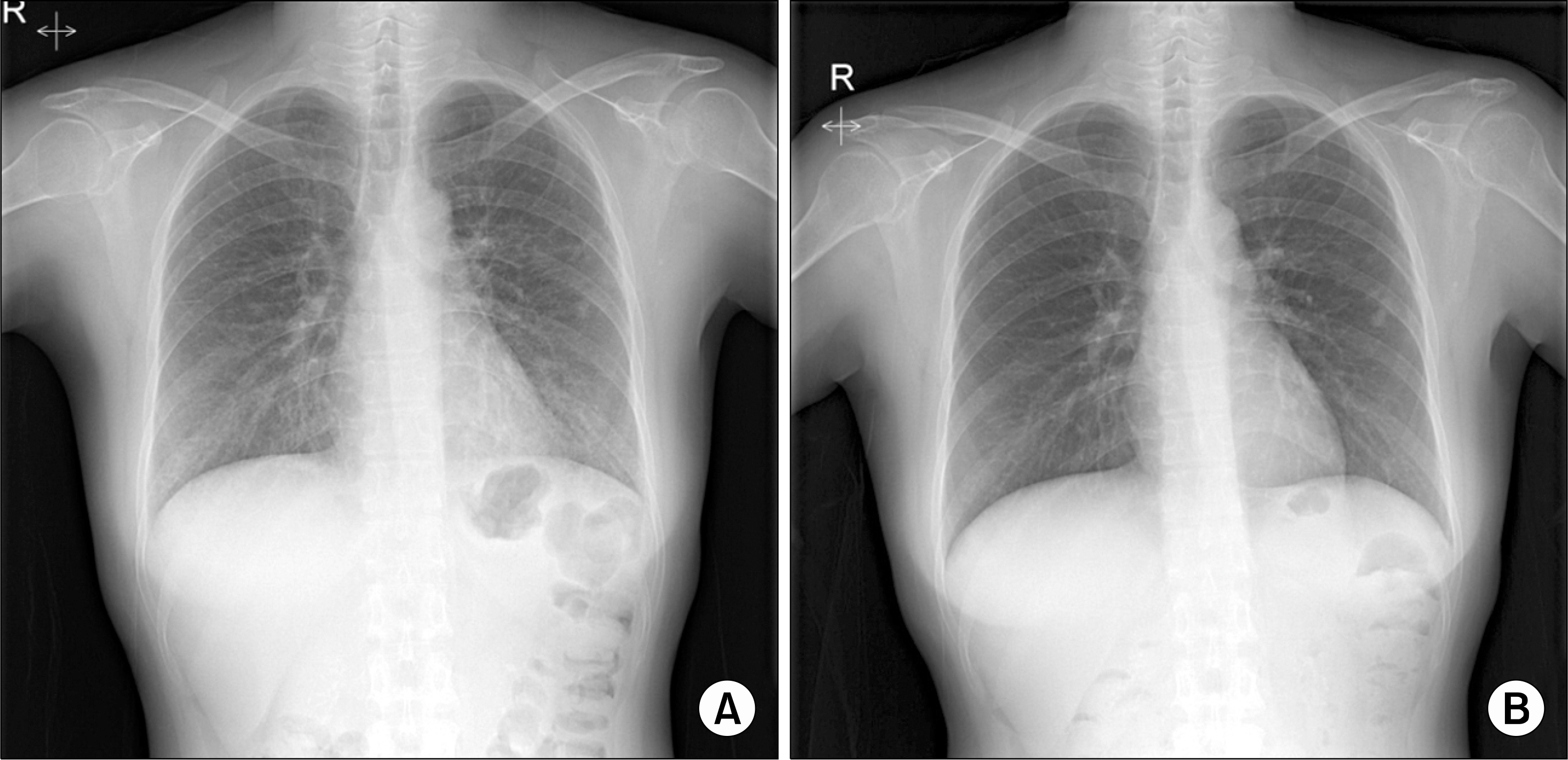J Korean Soc Transplant.
2015 Dec;29(4):242-246. 10.4285/jkstn.2015.29.4.242.
Late Onset Infection of Pneumocystis jirovecii Infection in a Renal Transplant Recipient
- Affiliations
-
- 1Department of Internal Medicine, Bong Seng Memorial Hospital, Busan, Korea. kidney119@hotmail.com
- KMID: 2202611
- DOI: http://doi.org/10.4285/jkstn.2015.29.4.242
Abstract
- Pneumocystis jirovecii pneumonia (PCP) can be a life-threatening opportunistic infection after kidney transplantation, occurring most frequently in the first 12 months with the symptoms of dyspnea, cough, fever, and hypoxia. Prophylaxis for PCP is usually applied during the first 3 months to 1 year after transplantation, but late onset incidence of PCP can be detected. We report on a patient who developed PCP 9 years after renal transplantation. The patient showed indolent onset of acute respiratory distress and was treated with trimethoprim-sulfamethoxazole and corticosteroid therapy. Previous rescue treatment of acute cellular rejection with ongoing maintenance of an elevated level of immunosuppressants may have predisposed the patient to PCP.
MeSH Terms
Figure
Reference
-
References
1). Alangaden GJ, Thyagarajan R, Gruber SA, Morawski K, Garnick J, El-Amm JM, et al. Infectious complications after kidney transplantation: current epidemiology and associated risk factors. Clin Transplant. 2006; 20:401–9.
Article2). Radisic M, Lattes R, Chapman JF, del Carmen Rial M, Guardia O, Seu F, et al. Risk factors for Pneumocystis carinii pneumonia in kidney transplant recipients: a case-control study. Transpl Infect Dis. 2003; 5:84–93.3). Thomas CF Jr, Limper AH. Pneumocystis pneumonia. N Engl J Med. 2004; 350:2487–98.
Article4). Fishman JA, Rubin RH. Infection in organ-transplant recipients. N Engl J Med. 1998; 338:1741–51.
Article5). Struijk GH, Gijsen AF, Yong SL, Zwinderman AH, Geerlings SE, Lettinga KD, et al. Risk of Pneumocystis jiroveci pneumonia in patients long after renal transplantation. Nephrol Dial Transplant. 2011; 26:3391–8.
Article6). Sepkowitz KA. Opportunistic infections in patients with and patients without acquired immunodeficiency syndrome. Clin Infect Dis. 2002; 34:1098–107.
Article7). Neff RT, Jindal RM, Yoo DY, Hurst FP, Agodoa LY, Abbott KC. Analysis of USRDS: incidence and risk factors for Pneumocystis jiroveci pneumonia. Transplantation. 2009; 88:135–41.
Article8). Eitner F, Hauser IA, Rettkowski O, Rath T, Lopau K, Pliquett RU, et al. Risk factors for Pneumocystis jiroveci pneumonia (PcP) in renal transplant recipients. Nephrol Dial Transplant. 2011; 26:2013–7.
Article9). Lufft V, Kliem V, Behrend M, Pichlmayr R, Koch KM, Brunkhorst R. Incidence of Pneumocystis carinii pneumonia after renal transplantation. Impact of immunosuppression. Transplantation. 1996; 62:421–3.10). Arend SM, Westendorp RG, Kroon FP, van't Wout JW, Vandenbroucke JP, van Es LA, et al. Rejection treatment and cytomegalovirus infection as risk factors for Pneumocystis carinii pneumonia in renal transplant recipients. Clin Infect Dis. 1996; 22:920–5.
Article11). Walzer PD, Smulian AG. Pneumocystis species. Mandell GL, Bennett JE, Dolin R, editors. Mandell, Douglas, and Bennett's principles and practice of infectious diseases. 7th ed.Philadelphia: Churchill Livingstone/Elsevier;2010. p. 3377–90.
Article12). De Castro N, Xu F, Porcher R, Pavie J, Molina JM, Peraldi MN. Pneumocystis jirovecii pneumonia in renal transplant recipients occurring after discontinuation of prophylaxis: a case-control study. Clin Microbiol Infect. 2010; 16:1375–7.
Article13). Kidney Disease. Improving Global Outcomes (KDIGO) Transplant Work Group. KDIGO clinical practice guideline for the care of kidney transplant recipients. Am J Transplant. 2009; 9(Suppl 3):S1–155.14). Flori P, Bellete B, Durand F, Raberin H, Cazorla C, Hafid J, et al. Comparison between realtime PCR, conventional PCR and different staining techniques for diagnosing Pneumocystis jiroveci pneumonia from bronchoalveolar lavage specimens. J Med Microbiol. 2004; 53(Pt 7):603–7.
Article15). Torres J, Goldman M, Wheat LJ, Tang X, Bartlett MS, Smith JW, et al. Diagnosis of Pneumocystis carinii pneumonia in human immunodeficiency virus-infected patients with polymerase chain reaction: a blinded comparison to standard methods. Clin Infect Dis. 2000; 30:141–5.
Article16). Yazaki H, Goto N, Uchida K, Kobayashi T, Gatanaga H, Oka S. Outbreak of Pneumocystis jiroveci pneumonia in renal transplant recipients: P. jiroveci is contagious to the susceptible host. Transplantation. 2009; 88:380–5.
Article
- Full Text Links
- Actions
-
Cited
- CITED
-
- Close
- Share
- Similar articles
-
- Late-Onset Granulomatous Pneumocystis jirovecii Pneumonia in A Renal Transplant Recipient: A Clinical Grand Round Conference Case in 2022
- A Case of Pneumocystis jirovecii Pneumonia Following CMV Duodenitis in a Kidney Transplant Patient
- Immunohistochemical Identification of Pneumocystis jirovecii in Liquid-based Cytology of Bronchoalveolar Lavage: Nine Cases Report
- Infection Prevention in Transplant Recipients
- Correspondence Regarding the Article Titled “Low Lymphocyte Proportion in Bronchoalveolar Lavage Fluid as a Risk Factor Associated with the Change from Trimethoprim/sulfamethoxazole Used as First-Line Treatment for Pneumocystis jirovecii Pneumonia”



